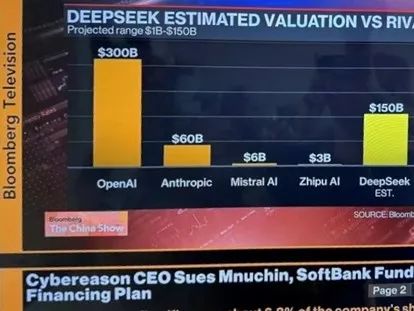DeepSeek's Global Impact Highlights Baidu's Challenges
![]() 02/14 2025
02/14 2025
![]() 465
465

At the dawn of 2025, DeepSeek sent shockwaves across the globe. Where success stories abound, so too do tales of struggle. Is Baidu feeling the heat? Indeed, and DeepSeek's influence extends far beyond Baidu, resonating worldwide.
Written by | Lan Dong Business Zhao Weiwei
What is DeepSeek's worth? One estimate places it at $150 billion.
This figure, sourced from Bloomberg and attributed to an interview with a startup founder, is based on a simple rationale: taking half of OpenAI's valuation. With SoftBank Group finalizing a $40 billion investment in OpenAI, valuing it at $300 billion, DeepSeek's current valuation stands at $150 billion.
DeepSeek has yet to comment on this valuation, and outsiders find it challenging to offer a definitive answer due to the company's lack of public funding, revenue, profit, and capital structure details. Its investments stem solely from founder Liang Wenfeng's quantitative trading endeavors.

This, however, doesn't deter the outside world from envisioning the best for DeepSeek.
As indicated, Bloomberg TV subsequently adopted the $150 billion valuation, positioning DeepSeek as the second-most valuable large-model startup globally, trailing only OpenAI and ahead of Anthropic, founded by former OpenAI members. In China, this valuation places DeepSeek second only to ByteDance among unicorn companies.
This valuation might represent an upper limit. A $150 billion DeepSeek ranks among the top five Chinese internet companies listed on the stock market, currently second only to Pinduoduo's market cap and roughly five times Baidu's market cap.
In reality, Bloomberg's article offers a wide range: $1 billion to $150 billion.
Interviews with various startup founders and AI experts yielded vastly different answers. A narrower range, between $2 billion and $30 billion, comes from the Bloomberg Billionaires Index, offering a more moderate valuation for DeepSeek.
A $30 billion valuation might be one of the more realistic answers, at least it upholds the lower limit of DeepSeek's valuation and closely aligns with Baidu's current total market cap.
Earlier, market rumors suggested that Alibaba planned to invest $1 billion at a $10 billion valuation, acquiring a 10% stake in DeepSeek. Alibaba quickly debunked this news, and the outside world didn't take it seriously. On one hand, Liang Wenfeng explicitly stated that there are no funding plans in the short term. On the other hand, a $10 billion valuation seemed too low and unrealistic.
Comparing Baidu with DeepSeek is pertinent because Baidu was the first among China's leading internet companies to release a large-model product.
In March 2023, Baidu launched Wenxin Yiyan, diving into the large-model arena. However, by 2024, Baidu's first-mover advantage in the large-model field was gradually surpassed by ByteDance's Doubao in terms of DAU. Originally, Baidu had a significant opportunity to collaborate with Apple on AI for mainland China iPhones, but recently, it was confirmed that Alibaba would also share this pie. Apple's move aims to mitigate risks through multiple partnerships.
As we stand at the beginning of 2025, with DeepSeek causing a global stir, beneficiaries and casualties alike emerge. Is Baidu feeling pressured? Yes, and DeepSeek's impact is felt worldwide, affecting more than just Baidu.
Just this week, Baidu announced that starting April 1, 2025, Wenxin Yiyan will be completely free, accessible to all PC and APP users. Additionally, foreign media disclosed that Baidu will release an updated Wenxin 5.0 model in the second half of the year, significantly enhancing multimodal capabilities. Meanwhile, OpenAI will also unveil a model called GPT-5 in the coming months.
DeepSeek serves as a catalyst for all global tech companies, while Baidu can be seen as a contrasting case. The path to AGI (Artificial General Intelligence) will undoubtedly witness even fiercer competition.
The valuation range from $30 billion to $150 billion encapsulates the future imagination space for DeepSeek. This question can be simplified: Is DeepSeek worth 1 Baidu or 5 Baidus?
On the wrong side of history?
——Any ETA for GPT-4.5 / GPT-5? Weeks? Months? (When is GPT-4.5 or GPT-5 expected to launch? In weeks or months?)
——weeks / months
This is the latest news revealed by Sam Altman on social media, another ambitious promise made under the pressure of DeepSeek.
OpenAI's latest roadmap includes not only unveiling GPT-4.5 or GPT-5 in the coming months but also offering GPT-5 for free to users currently utilizing ChatGPT for free. Paid subscribers will be able to run GPT-5 at a higher intelligence level.
GPT-4.5, internally known as 'Orion' at OpenAI, will be the last non-chain-of-thought model. In other words, models after GPT-4.5, like DeepSeek, will exhibit the model's thinking process, selecting appropriate thought paths to solve problems across different domains and tasks based on learned knowledge and experience, demonstrating strong flexibility and adaptability.
GPT-5, long rumored and gathering OpenAI's strongest capabilities, will not only feature multimodal abilities to process speech and images but also boast a 'deep research' function and significant advancements in advanced reasoning capabilities. The performance improvements will exceed current expectations, marking a qualitative leap similar to that from GPT-3 to GPT-4.
Furthermore, OpenAI aims to simplify its products by unifying models and eliminating model selectors, meaning its products will be more focused, and users will no longer need to manually select different AI models to complete tasks. All model selectors will return to 'magical unified intelligence.'
OpenAI's announcement of this roadmap is clearly a response to the pressure exerted by DeepSeek.
Previously, Altman acknowledged that the AI model developed by DeepSeek is on par with OpenAI's ChatGPT, praising it for doing an 'excellent job' in showcasing thought chains and achieving large-scale free applications, features users eagerly anticipate.
DeepSeek's open-source strategy has also weakened OpenAI's leading edge.
Altman admitted that OpenAI has 'stood on the wrong side of history' regarding open-source technology. OpenAI's closed-source development method will change in the future. Although this is not OpenAI's top priority at present, Altman is already considering a different open-source strategy and will open-source older models that are no longer advanced.
Open-source has also impacted Baidu. Open-source and closed-source models are not mutually exclusive. Robin Li has always believed that open-source is actually the most expensive in the large-model field, and open-source large models will increasingly lag behind. With equal capabilities, closed-source models offer lower inference costs and faster response speeds. With equal parameters, closed-source models also demonstrate stronger capabilities.
Shifting from the wrong side of history to following the trend is not easy, but fortunately, this realization is also dawning on Baidu.
Baidu's first change is to retain users with a comprehensive free strategy. Starting April 1, Baidu will offer Wenxin Yiyan completely free, accessible to all PC and APP users. Additionally, Wenxin Yiyan will launch a deep search function, also free to use from April 1.
However, this is clearly not enough, as DeepSeek has made users realize that usability is the real barrier. Even Doubao, with its leading edge, has been surpassed by DeepSeek in daily active users. QuestMobile data shows that DeepSeek's daily active users reached 32.86 million on February 1.
As DeepSeek's industry penetration and cost pressures rise, the outside world expects its commercialization to accelerate. However, industry insiders reveal that DeepSeek founder Liang Wenfeng doesn't seem to value these 30 million DAUs much, as his goal is to achieve AGI, not current DAUs.
Currently, DeepSeek shows no significant changes, neither initiating a charging model nor fully resolving server congestion issues. Insiders reveal that the DeepSeek team's current focus is on developing a series of more interesting and challenging products, expected to be released in the first half of this year.
Cheaper AI, Higher Demand
DeepSeek's emergence essentially burst the large-model bubble, bringing the tech industry back to rationality: utilizing more cost-effective AI capabilities to stimulate higher demand.
The global tech industry is impacted by DeepSeek, and deeper shocks in the AI industry may be imminent. After the financial reports of Amazon, Google, Microsoft, and Meta were released, data showed that their capital expenditures in 2025 will exceed $320 billion. Meta's capital expenditure this year will reach $60 billion to $65 billion, a significant increase from $39.23 billion in 2024, with a key reason being its bet on AI.
Starting next week, the latest financial reports of Baidu, Alibaba, and Tencent will be released, potentially offering a crucial comparison of Chinese and American tech forces' investments in AI.
From data in the third quarter of last year, Alibaba and Tencent maintained high investments. Alibaba's capital expenditure reached 17.49 billion yuan, while Tencent's capital expenditure also hit 17.1 billion yuan. Both made substantial investments in computing resources and AI infrastructure, with Alibaba's capital expenditure reaching an all-time high.
In contrast, Baidu has clearly fallen behind. With its revenue growth rate declining, it has been more cautious with capital expenditure. In the third quarter of 2024, Baidu's core business (excluding iQIYI) had a capital expenditure of 1.64 billion yuan, down 53.54% year-on-year, far from the same order of magnitude as Tencent and Alibaba.
Sharp cost reductions and value explosions are DeepSeek's hallmarks, but the amount of resources invested remains a crucial metric for measuring the intelligence of AI models.
DeepSeek has built stronger AI technology at a lower cost, but Altman still emphasizes a consensus: the intelligence of a model roughly equals the logarithm of the resources used to train and run it. 'These resources mainly include training computing power, data, and inference computing power. It seems that by investing any amount of funds, one can achieve continuous and predictable improvements; the scaling laws predicting this situation are accurate across multiple orders of magnitude.'
The huge gap in capital expenditures between Baidu and Alibaba might serve as a footnote to Apple's current choice to collaborate with both. With Baidu's Wenxin Yiyan becoming free in April, Chinese iPhone 16 series users will also start using AI features integrated with multiple Chinese partners.
Of course, don't forget that Apple's intelligence also encompasses its own foundational language models, including a roughly 3 billion-parameter model designed for efficient on-device operation and a large server-based language model designed for private cloud computing.
Alibaba's AI model will be deeply integrated into the iOS system, covering functional modules such as voice interaction, image generation, and personalized recommendations. Official sources reveal that Apple chose Alibaba primarily considering 'technical compatibility, ecosystem synergy, and policy compliance.'
But why didn't it choose DeepSeek, which is currently in the limelight? Even Tim Cook mentioned DeepSeek during the earnings call, viewing it as a 'good thing that drives efficiency innovation.'
One reason is that the DeepSeek team lacks the manpower and experience to support major clients like Apple. But a more important reason might be that the DeepSeek team's ambitions lie elsewhere. Large models are just one part of a long accumulation process, and they are busy with more crucial technological research. Their vision for technology-driven innovation extends far beyond this.
For Alibaba, collaborating with Apple undoubtedly offers a vast AI application scenario and higher demand for C-end usage. One of the shocks and revelations brought by DeepSeek to the industry is that while B-end clients are important, leveraging the scale of C-end users is even more crucial.
As Joseph Tsai mentioned at the World Government Summit in Dubai, with the DeepSeek phenomenon, people will start to shift their focus, no longer investing tens of billions of dollars in computing infrastructure just to train the brightest minds to become PhD students and Nobel laureates. 'We should concentrate on the real problems of the world and solve them with AI. Therefore, many people will start investing resources in application fields.'
This is the imagination space that DeepSeek brings to the future, far more valuable than its price tag.





